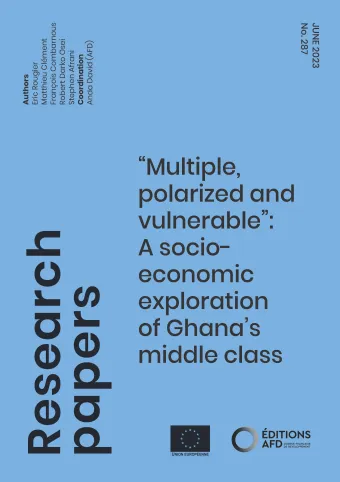Share the page
“Multiple, polarized and vulnerable”: A socio-economic exploration of Ghana’s middle class
Published on

By using mixed quantitative-qualitative methods combining micro-data from the Ghana Living Standards Survey 2016-2017 (GLSS7) and original qualitative data collected from semi-structured interviews in 2022, the present study provides a deeper and comprehensive analysis of the objective (consumption, occupation, education, socio-professional group, attitudes) and subjective (preferences, values, perceptions and expectations) characteristics of those assimilated to the Ghanaian middle class. After identifying a middle class of consumption out of a representative sample of the Ghanian population, a cluster analysis using socio-economic characteristics of the household head (education, occupation, socio-professional category) is conducted and shows the strong socio-economic fragmentation of this segment, with no less than five distinct groups presenting distinctive characteristics. The Ghanaian middle class is also strongly polarized, opposing, with equal shares, a lower middle class of uneducated and vulnerable informal workers and a upper middle class incorporating a large share of small and informal, albeit successful, entrepreneurs, and characterized by higher consumption and educational outcomes and relatively lower vulnerability. The subsequent qualitative analysis conducted on 40 individuals sampled to be representative of the Ghanaian middle class socio-economic structure highlights that intergenerational social mobility is perceived as being low in general, with education being seen as the main catalyst for breaking the cycle. A large gap exists between the lower middle-class reporting being vulnerable to shocks and short of means to weather them, and higher middle class being able to mobilize legal, financial and social resources to increase their resilience. A similar gap is documented between the two groups as to the access to social services or infrastructures, be they provided by the private or the public sector. While perceptions of gender opportunities or of the stakes of sanitation and environmental are aligned with gaps in objective access, the vision that education is key for securing their economic future is widely shared across groups, those in the lower middle class being less able to afford private schools. Finally, lower middle class are more critical than the upper middle class of the political elites, notably on the ground that the latter’s preferences are not always aligned to those of the people they represent.
Useful Information
-
Authors
-
Eric ROUGIER , Matthieu CLEMENT, François COMBARNOUS, Robert DARKO OSEI, Stephen AFRANIE
-
Edition
-
287
-
Number of pages
-
53
-
ISSN
-
2492 - 2846
-
Collection
-
Research Papers
